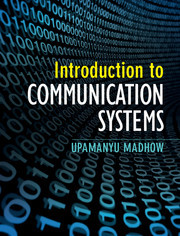Description
Introduction to Communication Systems
Author: Madhow Upamanyu
An accessible undergraduate textbook introducing key fundamental principles behind modern communication systems, supported by exercises, software problems and lab exercises.
Language: English
Subject for Introduction to Communication Systems:
Approximative price 57.55 €
In Print (Delivery period: 14 days).
Add to cart
Publication date: 11-2014
512 p. · 19.5x25.3 cm · Hardback
512 p. · 19.5x25.3 cm · Hardback
Description
/li>Contents
/li>Biography
/li>
Showcasing the essential principles behind modern communication systems, this accessible undergraduate textbook provides a solid introduction to the foundations of communication theory. Carefully selected topics introduce students to the most important and fundamental concepts, giving students a focused, in-depth understanding of core material, and preparing them for more advanced study. Abstract concepts are introduced to students 'just in time' and reinforced by nearly 200 end-of-chapter exercises, alongside numerous MATLAB code fragments, software problems and practical lab exercises, firmly linking the underlying theory to real-world problems, and providing additional hands-on experience. Finally, an accessible lecture-style organisation makes it easy for students to navigate to key passages, and quickly identify the most relevant material. Containing material suitable for a one- or two-semester course, and accompanied online by a password-protected solutions manual and supporting instructor resources, this is the perfect introductory textbook for undergraduate students studying electrical and computer engineering.
Part I. Introduction: 1.1 Analog or digital?; 1.2 A technology perspective; 1.3 The scope of this textbook; 1.4 Why study communication systems?; 1.5 Concept summary; 1.6 Notes; Part II. Signals and Systems: 2.1 Complex numbers; 2.2 Signals; 2.3 Linear time-invariant systems; 2.4 Fourier series; 2.5 The Fourier transform; 2.6 Energy spectral density and bandwidth; 2.7 Baseband and passband signals; 2.8 The structure of a passband signal; 2.9 Wireless-channel modeling in complex baseband; 2.10 Concept summary; 2.11 Notes; 2.12 Problems; Software labs; Part III. Analog Communication Techniques: 3.1 Terminology and notation; 3.2 Amplitude modulation; 3.3 Angle modulation; 3.3.1 Limiter-discriminator demodulation; 3.4 The superheterodyne receiver; 3.5 The phase-locked loop; 3.6 Some analog communication systems; 3.7 Concept summary; 3.8 Notes; 3.9 Problems; Software labs; Part IV. Digital Modulation: 4.1 Signal constellations; 4.2 Bandwidth occupancy; 4.3 Design for bandlimited channels; 4.4 Orthogonal and biorthogonal modulation; 4.5 Proofs of the Nyquist theorems; 4.6 Concept summary; 4.7 Notes; 4.8 Problems; Software lab; Appendices; Part V. Probability and Random Processes: 5.1 Probability basics; 5.2 Random variables; 5.3 Multiple random variables, or random vectors; 5.4 Functions of random variables; 5.5 Expectation; 5.6 Gaussian random variables; 5.7 Random processes; 5.8 Noise modeling; 5.9 Linear operations on random processes; 5.10 Concept summary; 5.11 Notes; 5.12 Problems; Appendices; Part VI. Optimal Demodulation: 6.1 Hypothesis testing; 6.2 Signal-space concepts; 6.3 Performance analysis of ML reception; 6.4 Bit error probability; 6.5 Link-budget analysis; 6.6 Concept summary; 6.7 Notes; 6.8 Problems; Software labs; Part VII. Channel Coding: 7.1 Motivation; 7.2 Model for channel coding; 7.3 Shannon's promise; 7.4 Introducing linear codes; 7.5 Soft decisions and belief propagation; 7.6 Concept summary; 7.7 Notes; 7.8 Problems; Part VIII. Dispersive Channels and MIMO: 8.1 The single-carrier system model; 8.2 Linear equalization; 8.3 Orthogonal frequency-division multiplexing; 8.4 MIMO; 8.5 Concept summary; 8.6 Notes; 8.7 Problems; Software labs.
Upamanyu Madhow is Professor of Electrical and Computer Engineering at the University of California, Santa Barbara. His research interests broadly span communications, signal processing and networking, with current emphasis on next-generation wireless and bio-inspired approaches to networking and inference. He is a recipient of the NSF CAREER Award and the IEEE Marconi prize paper award in wireless communication, author of the graduate-level textbook Fundamentals of Digital Communication (2008) and a Fellow of the IEEE.
© 2024 LAVOISIER S.A.S.




